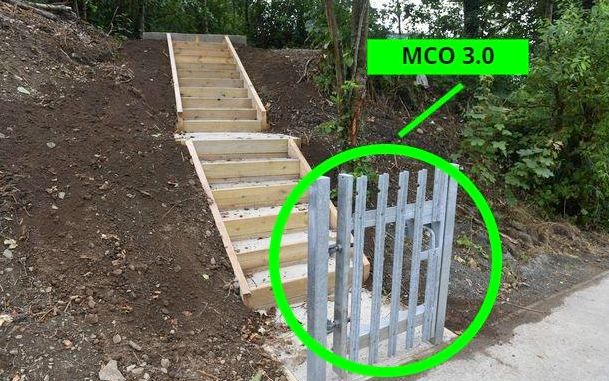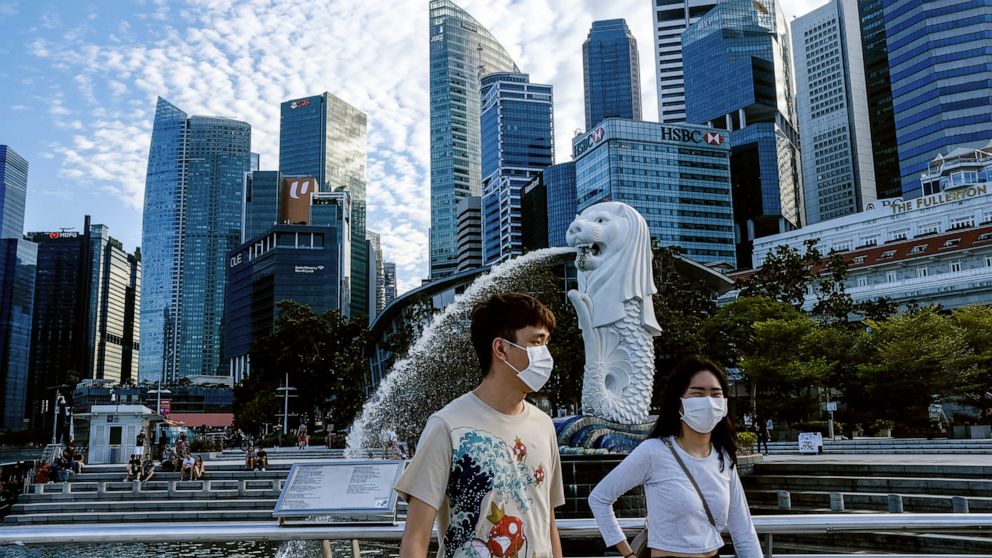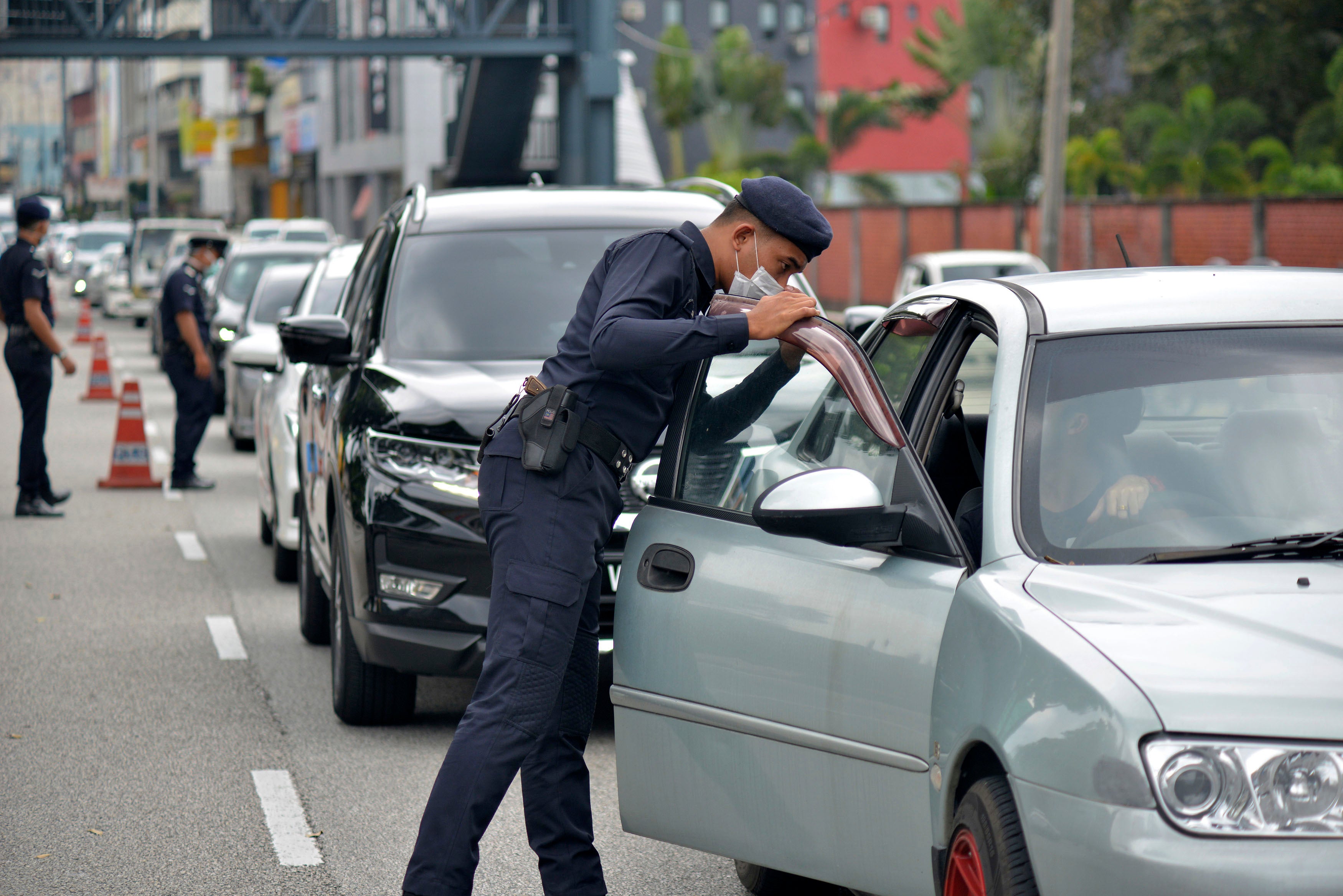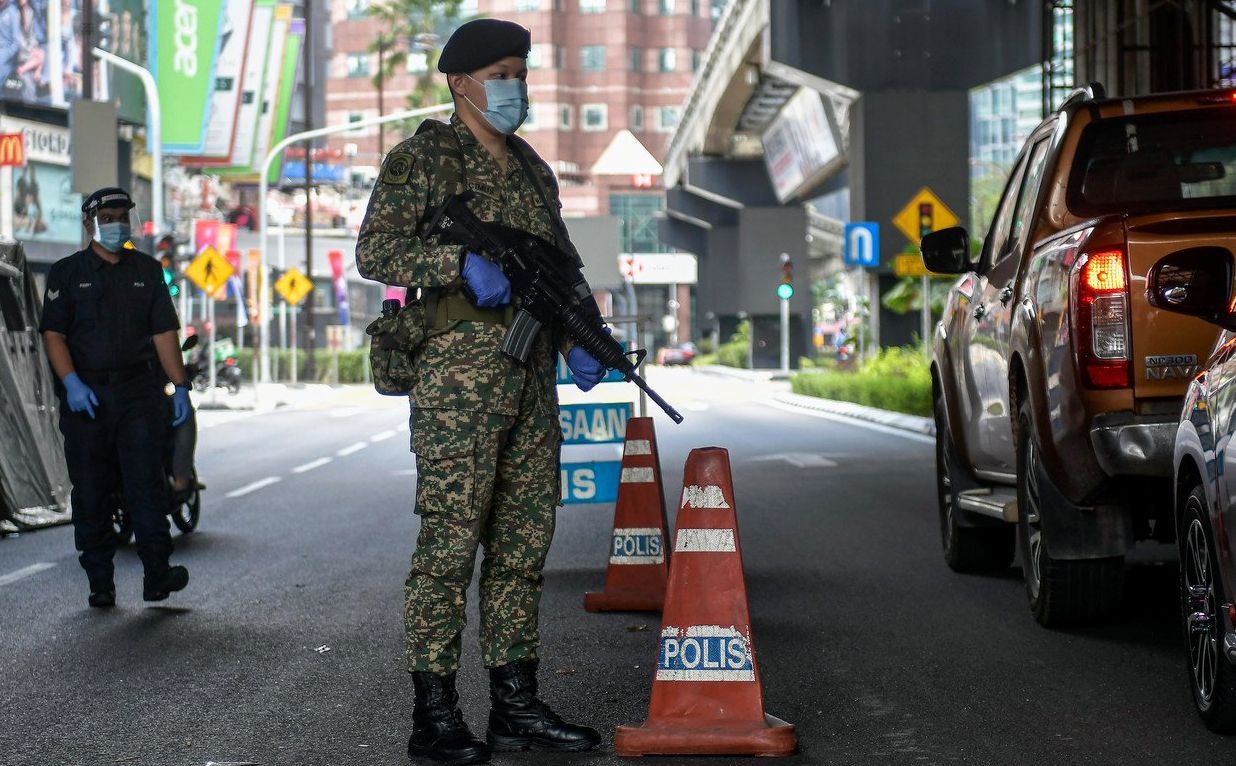A full month of nationwide lockdown and well over 200,000 vaccine doses given daily – and none of Malaysia’s Covid-19 numbers are really improving. People are increasingly wanting to know why. An answer may lie in completely changing our approach to the virus.
They say a picture paints a thousand words, so look carefully – very carefully – at the opening image of this article. Zoom in if you have to, but consider all its elements. The deserted, utterly joyless streets in one of Kuala Lumpur’s busiest, most energetic districts. The face shields and surgical masks. The nitrile medical gloves. The barricades. The semi-automatic weapons.
Really look at this photo: Is this how we want to live – indefinitely? Freedoms curtailed. Businesses failing. Loved ones separated. Mental health fraying. Lurching from one lockdown to another, with no defined end now even in sight, 16 months after it all started. Is this the sort of life we want for ourselves and our families?
If not, we need to consider different ways of approaching the Covid-19 pandemic. Our editorial opinion follows.
One month ago, with Covid cases spiking and so-called ‘Hari Raya clusters‘ popping up all over the country – along with Malaysia’s healthcare system becoming more and more overburdened – a two-week nationwide lockdown was announced. The Full Movement Control Order (FMCO), which was set to run from June 1 to June 14, came right on the heels of what was being called MCO 3.0.
New daily cases indeed fell from their worrying peak of 9,020, a number logged on May 29, but it’s likely they would have decreased with or without the FMCO, as there is a latency period of several days to two weeks between infection and detection. That means any results from the lockdown wouldn’t been reflected immediately in daily new cases, and as we got further away from the Hari Raya holidays that fuelled some of the spike, it made sense that cases would grow, peak, and then subside.
Indeed, by May 31, the new cases had already plunged to 6,824 – still high, but a nearly 25% drop from just two days earlier. And that’s before the lockdown even officially kicked in. By June 7, daily cases had decreased to 5,271.
Still, despite a sizeable drop in average new daily cases, the full lockdown was – to the surprise of very few – extended until June 28.
Unfortunately, even with an encouragingly rising rate of vaccinations (now averaging over 210,000 per day) and a solid month of lockdown efforts, things in Malaysia have not meaningfully improved much at all since then. Unsurprisingly, people are wondering why that is, and why we are sacrificing jobs, businesses, and the fraying mental health of a lot of people when we’re not seeing the health-related benefits from those sacrifices.

WHY IS MALAYSIA’S COVID PICTURE NOT IMPROVING?
From our perspective, there are two possible broad answers, both of which lead to more questions: Either the steps being taken are simply not working, or the Covid numbers being collected and/or released are somehow inaccurate.
There is also a third possibility which primarily affects just one of the metrics – new daily cases – but since that’s one of the major numbers being used to determine when and if we move from phase to phase under the FMCO and National Recovery Plan, this answer matters, and it centres on how and where testing is being carried out. More testing, particularly in known hotspots, unquestionably results in more infections being detected.
The government has set what is, according to experts, a fully arbitrary number of 4,000 new cases per day as a threshold before we can move from Phase 1 to Phase 2 of the National Recovery Plan. According to epidemiologists, this is a completely meaningless number, and as one person on Instagram cheekily posted, “Want to go below 4,000? Stop testing so much la.”
The wry humour of that comment belies a truth we must consider, though: New daily case numbers can – and often are – directly tied to the deployment of testing.
And beyond that, the inverse of that comment is also valid, too. If you wanted to stay above 4,000 for whatever reason, you would only need to increase testing overall, or shift it to areas where small outbreaks were known.
Indeed, it was curious to see that for three consecutive days last week, in a country of almost 33 million, that the new daily cases recorded were nearly identical – 5,841, 5,812, and 5,803. (Even more curiously, the daily deaths on those same three consecutive days were also nearly identical – 84, 82, and 81.)
There is no evidence to suggest that this is anything more than an odd coincidence, but it underscores the point that only when testing is consistently applied do the daily movements in recorded new cases have any real meaning, particularly with regard to a “recovery” effort.

FOCUS ON DIFFERENT DATA POINTS
We feel that the more critical metrics are the number of people who are getting severely ill (requiring hospitalisation), and those who are dying. We also still contend that possibly the most important number to follow is the number of vaccine doses being given – and what percentage of the population has been vaccinated.
Pinning a nation’s recovery to a totally arbitrary and highly variable measurement like new daily cases simply doesn’t make good sense. (As one epidemiologist pointed out, if you apply 4,000 to the whole country, you could theoretically have just a few cases scattered over many areas of the country and 4,000 in just KL and Selangor, giving Malaysia as a a whole a total of over 4,000 cases, and thus illogically and unfairly dooming the entire country to continued lockdowns.)
What may make better sense, for just one example, would be saying, “Once our ICU occupancy falls below 75% of capacity, and we’re giving more than 250,000 vaccine jabs a day on average, we can then start relaxing the SOPs and restrictions. Then, when ICU occupancy falls below 50% of capacity, and at least 40% of the vaccine-eligible population is fully vaccinated, we can open up further, and resume interstate travel.”
Not only is this easy to do, it’s not even especially hard to predict how it would play out on a given timeline. We have all the Malaysia-specific numbers we need, and we have amassed enough global data on Covid-19 to know, as a general rule, what percentage of infected people develop symptoms. We also know what percentage of those require medical intervention (“serious”) or hospital care (“critical”) – currently around 0.7% of active cases worldwide for both categories collectively. Malaysia’s own numbers show that 1.4% of all active cases in the country are severe, requiring ICU levels of care. That means that 98.6% of all Malaysia’s ongoing cases are either asymptomatic or mild.
A mathematical model can effortlessly handle all of these continuously moving data points, and can be adjusted as necessary after deploying the strategy. (The CDC tracks all of this meticulously, though their data are almost all for the United States.) Since there is a known capacity for Malaysia’s healthcare system, simply work backwards from an acceptable maximum occupancy load (say, 80%) and use that as a benchmark, rather than just making up a random round number for daily new cases, whether it’s 4,000, or 2,000, or 500. Those numbers just don’t really mean anything in a recovery plan.
And now, since we still have not even come close to dropping below the arbitrary number of 4,000 daily cases, the Prime Minister announced on June 27 that there would be no lifting or relaxing of the FMCO (though eateries will now be able to operate take-out and delivery business until 10pm), but rather it would continue indefinitely until this magic number, which we know can be easily influenced by the “how and where” of testing, is reached.

SINGAPORE: THERE IS ANOTHER WAY
Our neighbour to the south has largely had a good deal of success in managing the pandemic. Singapore has faced a number of challenges – including a runaway surge in cases last year among their migrant worker population, and a current struggle against the Delta variant of the virus – but has fared well overall since the Covid-19 crisis began.
Throughout the pandemic, in analysing the current data, we can say that they’ve maintained about double the effectiveness of Malaysia in containment, adjusting for population. (That’s 22,397 cases per 1M population for Malaysia vs 10,608 cases per 1M population for Singapore.) The world’s rate overall is 23,332, so Malaysia is very average in this respect.
Where Singapore has truly excelled, however, is in mitigating severe illness and death. Malaysia’s Covid death rate is 151 per 1M population. That’s much better than the world average of 505, but Singapore’s rate is just six deaths per 1M population, among the lowest in the world. Put another way, Malaysia has a death rate 25 times higher than Singapore’s. Perhaps we should take a cue and learn from both the mistakes and successes of other countries.

Now, Singapore’s leaders have decided – wisely, we feel – that as the vaccines have provided a clear roadmap for mitigating the spread and seriousness of the virus, the time has come to completely change the strategy.
Singapore has realised that we will not completely eradicate SARS-CoV-2. We will not achieve zero new cases every day in perpetuity. So rather than careening from one failed plan to another, going in and out of lockdowns, and “circuit breaker” strategies, and targeting various economic sectors for shutdowns… that it’s time to just learn to live with this virus, just as we have for other endemic pathogens.
In line with this new strategy, which has not yet been rolled out, there will be no goals of zero community transmission. Quarantine will be removed for travellers, and close contacts of cases will not have to isolate. Singapore also plans to no longer announce daily case numbers.
This is part of the new normal, they say. “The bad news is that Covid-19 may never go away. The good news is that it is possible to live normally with it in our midst,” wrote Singapore’s Trade Minister Gan Kim Yong, Finance Minister Lawrence Wong, and Health Minister Ong Ye Kung in an editorial in The Straits Times. The three ministers comprise the leadership of a multi-ministry task force in Singapore.
Singapore currently has strict border controls in place with most countries, including tests on arrival, hotel quarantine, and stay-at-home orders. But all that would be stopped under the plan, once the country is at a point to implement it.
“Every year, many people catch the flu. The overwhelming majority recover without needing to be hospitalised, and with little or no medication. But a minority, especially the elderly and those with comorbidities, can get very ill, and some succumb.
“We can’t eradicate [Covid-19], but we can turn the pandemic into something much less threatening, like influenza or chickenpox, and get on with our lives,” the three ministers said in their statement.
The key is vaccination, they say, and once a certain threshold has been reached, the new strategy can be deployed. Singapore expects to have two-thirds of its population fully vaccinated by early August.
Under the “new normal,” they would seek to tame Covid-19, not vanquish it. The vaccines provide nearly 100% effectiveness against severe illness or death, so even though some people may still get the disease, the symptoms will be mild, and they can recover at home, just as they do now for colds and the flu.
A big change – and hopefully someone in Malaysia will see this – is that Singapore would stop reporting daily new case numbers.
“Instead of monitoring Covid-19 infection numbers every day, we will focus on the outcomes: how many fall very sick, how many in the intensive care unit, how many need to be intubated for oxygen, and so on. This is like how we now monitor influenza.”
As we are now on day 467 of the “two-week” MCO (the first of which began on March 18, 2020), the current reality in Malaysia certainly suggests that the whole MCO-CMCO-MCO-FMCO approach is not working and is certainly not sustainable. On June 28, the Malaysian Employers Federation (MEF) called on the government to admit the lockdown wasn’t working – and end it.
“Perhaps the government needs to admit that the lockdown did not meet the desired results and therefore, should not be continued,” said MEF Executive Director Shamsuddin Bardan. “The government should allow all employers that are able to adhere to the SOPs to resume operations immediately to enable them to sustain their businesses.”
We agree with the growing number of business owners, trade groups, and everyday Malaysians who are calling for scrapping the endless lockdowns and movement restrictions and adopting a new strategy… not to defeat Covid-19, but to learn how to live with it.

"ExpatGo welcomes and encourages comments, input, and divergent opinions. However, we kindly request that you use suitable language in your comments, and refrain from any sort of personal attack, hate speech, or disparaging rhetoric. Comments not in line with this are subject to removal from the site. "





















